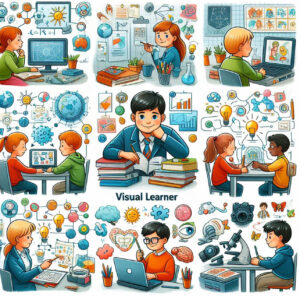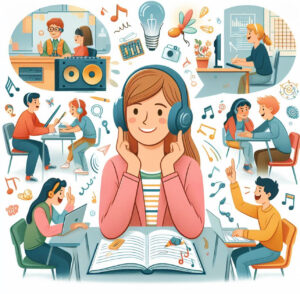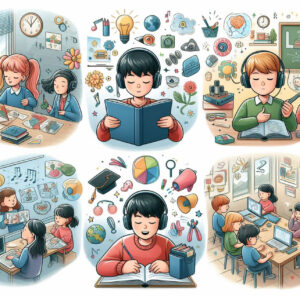

Effective Teaching Strategies for Different Learning Styles
Today let us learn more about Strategies for Effective Teaching for Different Learning Styles. Have you ever wondered why some students grasp new concepts quickly while others struggle to keep up? Or why do some students prefer to work in groups while others like to work alone? Why do some students prefer listening to lectures while others prefer reading or writing?
The answer may lie in the different learning styles of your students. Learning styles are the ways that people process and retain information. They affect how students learn, how they interact with others, and how they express themselves.
The VARK model is a popular way of categorizing learning styles, with four main types of learners: Visual, Aural, Reading/Writing, and Kinesthetic. Numerous theories and models of learning styles exist, but VARK is one of the most commonly utilized. Each type has its strengths, preferences, challenges, and limitations.


As a teacher, you may have your preferred teaching style, but it may only match the learning styles of some of your students. Therefore, being aware of the different learning styles and adapting your teaching strategies is essential. Doing so can enhance students’ learning outcomes, motivation, and satisfaction.
This article will discuss various learning styles and offer practical teaching tips and examples for each one.
Visual Learners
Visual learners learn best by seeing. They prefer to use images, diagrams, charts, maps, colors, and other visual aids to organize and understand information. Moreover, they have a good spatial sense and a vivid imagination.
Characteristics of visual learners
- They tend to be observant and pay attention to details.
- These learners like to use highlighters, symbols, and different fonts to emphasize key points.
- Also, they can easily visualize objects, situations, and outcomes.
- Moreover, learners under this category often need help with verbal instructions and may need to see them written down.
- In addition, they may get bored or distracted by long texts or speeches.

Teaching strategies
- It is recommended to use visual aids such as pictures, videos, graphs, and tables to help clarify and support your points during presentations or discussions.
- Provide handouts, outlines, or summaries of the main topics or concepts.
- Use color coding, symbols, or labels to categorize or classify information.
- Utilize charts or diagrams to show the relationships or connections between ideas.
- Also, make use of maps or timelines to show the sequence or progression of events.
- Additionally, use examples, analogies, or metaphors to help them visualize abstract concepts.
- Encourage them to draw, sketch, or doodle their notes or diagrams.
- Besides, ask them to create mind maps, flowcharts, or concept maps to organize their thoughts or review the material.
Aural Learners
Aural learners learn best by hearing. They prefer to use sound, music, rhyme, rhythm, and other auditory elements to acquire and recall information. Indeed, they have a good sense of pitch and tone.
Characteristics of aural learners
- They tend to be good listeners and can follow spoken directions well.
- Also, they use mnemonics, acronyms, jingles, or songs to memorize facts or formulas.
- This type of learner can easily repeat or explain what they have heard.
- Similarly, they often enjoy discussions, debates, and oral presentations.
- Although, they may need help with written assignments or tests and may need to hear them read aloud.

Teaching strategies
- Make use of verbal explanations, descriptions, or stories to introduce or reinforce concepts.
- Provide audio recordings, podcasts, or lectures that they can listen to at their own pace.
- Find a use for music, sound effects, or voice inflections to create interest or emphasize points.
- Moreover, use rhyme, rhythm, or repetition to help them remember critical information.
- Besides, encourage them to participate in discussions, debates, or role plays.
- Additionally, ask them to summarize, paraphrase, or explain their learning.
- Allow them to use oral reports, interviews, or podcasts as alternative assessments.
Reading/Writing Learners
Learners who are inclined towards reading and writing learn best through these activities. Individuals with solid linguistic skills often prefer learning and communicating through the written word. They have a knack for using language effectively, so their vocabulary is quite extensive.
Characteristics of reading/writing learners
- They are avid readers and writers and enjoy exploring different genres and formats.
- Learners under this category like to take notes, make lists, or write summaries of what they have learned.
- Besides, they can easily express themselves in writing and have good grammar and spelling.
- Also, they often prefer to study alone and in quiet environments.
- However, they may have difficulty with oral or visual instructions and may need to read them several times.

Teaching strategies
- You can use texts, books, articles, or other written materials as the primary source of information.
- Also, provide written instructions, guidelines, or feedback for assignments or tasks.
- Then utilize words, definitions, or quotations to explain or illustrate concepts.
- Encourage them to read widely and critically and to compare and contrast different sources or perspectives.
- Ask them to write essays, reports, journals, or blogs to demonstrate their understanding or express their opinions.
- Allow them to use dictionaries, thesauruses, or online resources to enhance their vocabulary or research skills.
- Challenge them to create their texts, stories, or poems based on the topics or themes covered.
Kinesthetic Learners
Kinesthetic learners learn best by doing. Mostly, individuals in this type of learning prefer physical activities, hands-on tasks, experiments, and simulations to understand and apply information. Also, they have a good sense of balance and coordination.
Characteristics of kinesthetic learners
- They tend to be active and energetic and enjoy moving around and exploring their surroundings.
- Similarly, they like to use gestures, body language, or facial expressions to communicate or emphasize points.
- Also, they can easily manipulate objects, tools, or instruments and learn by trial and error.
- Nevertheless, they often need help sitting still or focusing for long periods.
- Additionally, they may struggle with abstract or theoretical concepts and must see them in action.

Teaching strategies
- Introduce or review concepts using physical activities, games, or exercises.
- Provide hands-on tasks, experiments, or projects that allow them to apply what they have learned.
- Illustrate or demonstrate concepts using real-life examples, scenarios, or case studies.
- Encourage them to use models, props, or manipulatives to represent or visualize information.
- Ask them to perform, act out, or demonstrate what they have learned.
- Allow them to use portfolios, scrapbooks, or videos as alternative assessments.
- Challenge them to create activities, games, or experiments based on the covered topics or themes.
Conclusion
As you can see, different learning styles require different teaching strategies. By understanding and accommodating the various learning styles of your students, you can create a more inclusive, engaging, and effective learning environment for everyone.


However, keep in mind that learning styles are not fixed or rigid. They can vary depending on the subject, the situation, or the learner’s mood. Therefore, it is advisable to use various teaching methods and materials to cater to your students’ diverse needs and preferences. Remember, there is no one right way to teach or learn. The best way is the way that works for you and your students.
If you have any questions or comments on the impact of social media on education, feel free to leave them below. Thanks for reading, and see you at the next one!
References:
WGU Hey Teach. 2020, November 18. Accommodating different learning styles: 3 tips to guide you. https://www.wgu.edu/heyteach/article/accommodating-different-learning-styles-3-tips-guide-you-01702.html
Virtual Speech. 2020, October 29. Teaching strategies for the 8 different learning styles. https://virtualspeech.com/blog/teaching-strategies-different-learning-styles
Resilient Educator. n.d. Teaching styles: Different teaching methods & strategies. https://resilienteducator.com/classroom-resources/5-types-of-classroom-teaching-styles/




